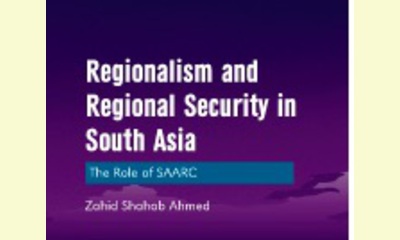|
|
Book Review of Zahid Shahab Ahmed, Regionalism and Regional Security in South Asia: The Role of SAARC
un articulo por Dharshani Premaratne South Asia Economic Journal, 15, 2 (2014): 315–356 (abridged)
The level of inter-dependency among South Asian
countries is growing due to the transnational and
interconnected nature of human security concerns
in the region. Human security challenges such as
poverty, hunger, water scarcity, natural disasters,
diseases and environmental degradation demand
for regional cooperation in South Asia. The
landlocked countries like Afghanistan, Bhutan and
Nepal not only depend on water and food from
neighbouring states but also on access to
seaports. To retain the current economic growth
level, India sources its energy needs mainly from
Bhutan, which is the biggest hydropower
electricity exporter to India, and India has also
shown interest over the natural gases of
Bangladesh and Iran via Pakistan to ensure future
energy needs.

Hence, profound economic and social
implications of the issues concerning human
security called for greater regional cooperation,
which resulted in forming the South Asian
Association of Regional Cooperation (SAARC) in
1985. However, South Asian regionalism has
suffered bilateral tensions and differences
between SAARC members along with individual
countries’ domestic disputes. Although most
studies label SAARC as a dysfunctional
organization that has failed to tackle bilateral
disputes, some studies find encouraging
developments in SAARC that deal with issues
related to human security.
For this reason, in Regionalism and Regional
Security in South Asia: The Role of SAARC,
the author attempts to find the extent to which
regional cooperation, through agreements and
actions in the areas of human security, can
strengthen regionalism. By conducting a
comprehensive reappraisal of SAARC’s progress
to date, the book analyzes the trends in economic,
environmental, food, water and energy insecurities
and transnational crimes in South Asia. It offers a
more realistic and balanced approach to study
regionalism through the lens of SAARC’s
structure, actions and challenges. . . .
The concluding chapter offers a comprehensive
argument on the functionalist approach to
regionalism in South Asia. This chapter also
summarizes the achievements made, with regard
to human security, and challenges faced by
SAARC. Ahmed deliberates over the difficulty of
comparing SAARC with other regional
organizations chiefly due to the length and depth
of the bilateral tensions between member
countries. The thought-provoking critical analyses
in the book offers a gamut of policy options not
just within the parameters of regionalism but also
for national development agendas of SAARC
members. Every chapter is intertwined and the
thread of South Asian regionalism is woven
effectively and taps into whole new dimensions of
South Asia-specific regionalism instead of
generalizing.
The book is an engaging read, especially for those
interested in South Asia’s progress of and
prospects for regional integration. Ahmed voices
his thoughts and experiences through this book to
restore the broader essence of South Asia and the
fruits of his endeavour can benefit policymakers in
South Asia to strategize their approach towards
South Asian regional cooperation.
Zahid Shahab Ahmed, Regionalism and
Regional Security in South Asia: The Role of
SAARC, Surrey: Ashgate Publishing Limited,
2013, pp. 217, £58.50, ISBN 978-1-4094-6769-4.
|








|
DISCUSSION
Pregunta(s) relacionada(s) al artículo :
If you have read this book, what do you think of it?,
* * * * *
Comentario más reciente:
:
I second Sheila Conroy's enthusiasm for this book, "The Truth." It is innovative and appealing; and accessible for any age level of reader from youth to adult.

|
|









